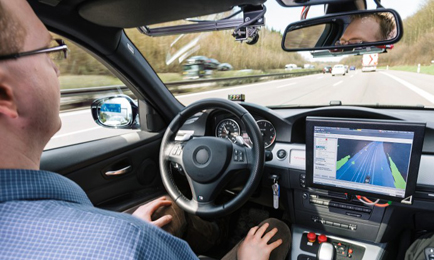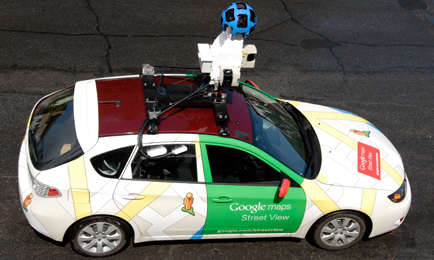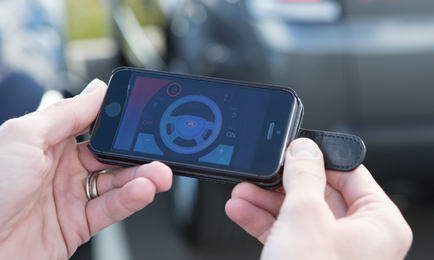Although we’re nowhere near fully autonomous cars becoming a standard mode of transport, several manufacturers are releasing remote driving systems that mark the first stage on the journey

The road to fully autonomous cars may seem long and winding, but ground is being broken in driver-assist semi-autonomous technologies that is sure to make the journey a lot smoother. The latest development has seen leading automotive companies – including BMW, Mercedes, Jaguar Land Rover and Bosch – launch remote driving systems that are controlled from a smartphone app or intelligent key fob.
Jaguar Land Rover (JLR) recently unveiled a prototype of its remote-control Range Rover Sport research vehicle that demonstrates how drivers can manoeuvre the car from outside it via their smartphone. The app includes control of steering, accelerator and brakes.
For JLR, the remote-control car represents a technological stepping stone towards the fully autonomous vehicle, says Mark Cund, research engineer for the project. The technology allows the driver to exit the vehicle to negotiate challenging terrain or difficult parking situations, while walking alongside the car and becoming their own off-road spotter, controlling the car from outside the vehicle, he says.
“This would allow them to guide the car remotely, navigating safely around off-road obstacles that may not be visible from inside,” says Cund.
This ‘self-spotting’ could include checking ramp approach and departure angles of a steep gradient, or allowing precise positioning of the vehicle when performing a rock crawl.
JLR envisages that as well as helping to avoid obstacles and navigate difficult terrain, the technology’s real-world uses will include getting a vehicle out of a tight parking space or a narrow townhouse garage, thereby avoiding everyday problems such as parking dents.
The system connects wirelessly from the phone to the car through a standard vehicle electronic control unit. It uses technology now in production via the smartphone app to control steering, throttle, brakes and gearbox, as if the motorist were inside the vehicle operating it normally.
If the paired smartphone is in range of the vehicle (15-20m), selecting ‘on’ on the phone will connect it and give control to the user of the phone. Selecting ‘off’ will give control back to the vehicle, after braking to a halt, then automatically entering parking.
The vehicle uses ultrasonic and camera sensors to bring it to a halt if a hazard is detected within its 360° ‘safety ring’. The size of the safety ring can be altered, and part of JLR’s research is to ensure that this is performed to match the stopping distance of the vehicle, says Cund.
Safety checks
As soon as any autonomy is handed over to vehicles one of the first questions to be raised is that of safety. The project is “designed with safety in mind”, he says, and when in remote control mode the vehicle can only move at 4mph. The app can operate only if the vehicle’s smart key is present and is operated within a 15-20m range. Furthermore, if the user drops the smartphone, the app senses this and will automatically put the car into ‘halt mode’, in which the vehicle applies the brakes, performing an emergency stop. “Halt mode is also applied if the user takes their fingers off the smartphone screen, as this suggests that they no longer have control over the vehicle,” says Cund.
He adds: “Cyber security is another safety consideration and something JLR is working on to create a state-of-the-art security protocol.”
With the vehicle being a research project, the remote control system is still being tested. While Cund is unable to share details of the tests, he says that the company has identified a list of hazardous situations and is ensuring that risks are reduced to acceptable levels. However, customers will have to wait a while to see the technology introduced into vehicles on the market, with the launch date set to be around 2020.
Future possibilities for this technology could include more autonomous functionality, where the driver gives a simple command from the handset to traverse an obstacle or exit a parking space and the car does the rest, JLR predicts.
Meanwhile, Bosch has been working hard on developing its automatic park-assist technologies with remote-control functions. Controlled from outside the car via a smartphone app, the system allows users to hold a button and start the parking manoeuvre. The vehicle will then drive itself into, or back out of, the parking spot autonomously. The process can be stopped by taking your finger off the button.
This automatic park-assist technology, which will be available later this year, is an evolution of Bosch’s parking assistant, which has been on the market since 2008 and uses ultrasound sensors integrated into the side of the vehicle to scan the surrounding area and identify suitable parking spaces. The system’s electronics then compute the most favourable steering manoeuvres and automatically guide the vehicle in and out of the parking space. However, in the current version, the driver controls the car by accelerating, braking and changing gear.

Trailer control
Moving this technology on, Bosch has developed a remote-controlled park-assist that can be used to accurately control the angle of trailers attached to a vehicle. This idea came about from an initial project to develop an algorithm to help drivers control the sway angle of trailers when operating their vehicle, particularly when reversing out of parking spaces, says Roland Greul, manager of advanced engineering, driver assistance and system interconnection at Bosch. “We realised the more challenging problem is that sitting in the car is not a solution for controlling the angle, because you have that big trailer behind you and it is difficult to oversee the situation, estimate the distance and see obstacles,” he says.
Instead, the company decided to use smartphone technology and combine it with the algorithm it had developed, so that drivers can overlook the entire situation and use the app to drive the vehicle train.
While Bosch already had algorithms that control road wheel angles for normal parking functions, the novel challenge was to develop an algorithm that controls the trailer’s sway angle by translating it into or requesting a road wheel angle, says Greul. “Once we realised this part, the rest of the technology was already there, as all the interfaces that referred to longitudinal and motion controls were available in the car.”
In the first prototype, Bosch began with a trailer coupling that used sensors to measure the sway angle out of an extension of the trailer coupling. However, the company has since altered this design and added a rear-view camera to feed back information about the trailer’s sway angle. “The position of the rear-view camera means it is possible to detect and analyse the trailer coupling and angle of the trailer. We use this trailer angle as actual information for our algorithm and the nominal angle is introduced by the app,” says Greul. Information about the trailer angle is gathered from the camera in 30 milliseconds and the algorithm calculates the appropriate sway angle in just 10ms.
Much of the other control technology is “normal interface systems” already developed by Bosch, including automatic gear transmission to shift gears and controls for vehicle velocity – an interface to the brake system and drivetrain, he says.
With regard to safety, the driver is still very much in control and is responsible for the guidance of the vehicle. If they observe a safety hazard, such as an obstacle or passer by, they simply lift their finger from the surface of the smartphone and the car will immediately stop.
“The driver has responsibility for the guidance of the vehicle train, and controls all the normal degrees of freedom they have in the car. They predefine a velocity that the trailer should drive – the gear is predefined so it is clear if it is forward or backward –
and then only by putting the finger on the app can you control the trailer’s sway angles,”
says Greul.
Speed limits
The top speed is also limited, to 4km/h driving forward and 2km/h in reverse. However, in both cases these safety elements have been created to meet the UN Economic Commission for Europe vehicle regulations, which limit top automatic steering speeds to 10km/h, and the Vienna Convention that states drivers must still be responsible for the overall control of the car.
The app communicates with the vehicle via Bluetooth, and operates from a distance of up to 20m. This method would be possible to hack, Greul admits, but both Bosch and automotive OEMs are working on this aspect to create a secure vehicle-to-smartphone connection.
Results from the trials of the technology have proved successful, and the user feedback has been promising. Both unskilled drivers – who do not drive a trailer combination – as well as, somewhat surprisingly, experienced drivers have been reporting back positively. “We thought the expert drivers would have problems with the system as they were used to translating the trailer’s sway angle through their own road wheel angle. But the feedback was curious, because they mention it is so easy that it makes sense to use the smartphone app,” says Greul.
The next improvement to the prototype will be to add extra environment sensors on the drawing vehicle, to ensure that no obstacles are missed when the driver’s attention is focused on controlling the trailer.
A bundle of functions related to this technology will inevitably be developed in the near future, including a completely autonomous parking function, says Greul.
He adds: “I think the smartphone could be integrated in many applications or adaptions of functions in cars. It is comfortable because you are used to your smartphone, and it is the easiest way to get the internet into the car, which is why Bosch has developed mySpin – a smartphone interface project where you can use your apps that are stored on your smartphone just by touching the interface in the car.”
For both JLR and Bosch, some of the biggest roadblocks to fully autonomous cars are still legal rather than technical, but smartphone developments are helping to pave the way and to prove the viability and safety of autonomous technology.
Cund says: “Legals are challenging, especially with the higher levels of autonomy. Liability is another, and public perceptions. From an engineering perspective, it’s challenging to get autonomous cars to work in all weather conditions, so sensing will become an area that will require expert knowledge.
“This is something JLR is working on and investing heavily in.”
 Did you know? Google self-driving car
Did you know? Google self-driving car Google’s self-driving car recently made headlines for being rear-ended by a human-driven car as it slowed to avoid traffic. Project director Chris Urman said the company’s autonomous cars are being driven into surprisingly often, and argued the crash is a perfect example of why self-driving technology would be beneficial for society.
 Did you know? JLR multi-point turn
Did you know? JLR multi-point turn Jaguar Land Rover is also developing a ‘Multi-Point Turn’ Range Rover Sport vehicle that can autonomously manoeuvre through 180° to help perform many drivers’ least favourite manoeuvre – the three-point turn. The system uses sensors to assess available space and to avoid pedestrians, vehicles and other objects. It then takes over gear selection, steering, braking and acceleration to make as many forward and backwards movements as necessary to achieve the manoeuvre. “Research into technologies such as these won’t only help us deliver an autonomous car – they will help make real driving safer and more enjoyable,” says Dr Wolfgang Epple, director of research and technology at JLR.